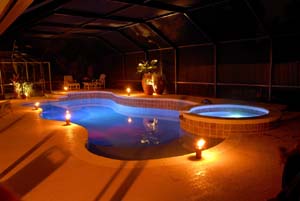Steps to Cleaning a Swimming Pool
Swimming pools are great additions to homes because they call families outdoors to play, swim, splash, and have lots of fun. Though being an owner of a pool comes with its responsibilities. One of these main responsibilities is cleaning the pool thoroughly and regularly. And, cleaning does not only encompass particle removing; one also must add chemicals to the pool so that it does not only look clean, but is microscopically.
The various steps to cleaning a swimming pool are not that difficult. As long as the owner maintains a schedule of cleaning and maintaining the pool throughout the week, especially during the summer, he/she will not be stuck doing a complete cleaning job. Therefore, maintenance is key; failing to regularly clean the pool will result in a toxic-looking mess that will spend hours to bring back to a normal level of cleanliness. To clean a pool, you will need the following materials:
Leaf Skimmer – This tool has a long handle with a net on the end to skim out particles.
Pool Vacuum – A pool specialized pool vacuum sucks up dirt from the pool floor.
Floor and Wall Brush – This brush is used to bust out caked on dirt on the sides and bottom of the pool.
Tile Brush – This is a smaller, hand-held brush that is used to get into small corners; it’s perfect for tile grout.
Algae Brush – Unlike a standard floor and wall brush, the algae brush is made of stainless steel to knock out algae from the sides of pools with walls made of plaster.
Outside of the aforementioned tools, the pool owner should have a clean filter, efficient pump, and adequate supply of water. Before attempting to clean the swimming pool, it is important to ensure all mechanisms are in place and clear of debris or any other obstructions. Although some, especially those cleaning the pool for the first time in a long time, empty the pool before cleaning it. Though this makes for adequate cleaning, it is not necessary. Emptying the pool makes sense only when it is extremely dirty and has not been cared for in a while. However, if you’re dealing with a particularly dirty pool and need to dispose of debris or waste, you can rent a dumpster from services like Dumposaurus Dumpsters & Rolloff Rental. The simple steps to cleaning a swimming pool when it is full of water are:
1. Skim out all larger debris (or anything else that does not belong) with the Leaf Skimmer. Anything that is still on the surface must be scooped out before moving on to the proceeding steps. If there is any debris, leaves, or other sediments on the bottom, you should try and move them a little bit with the skimmer and see if they float up; if they do, scoop them up and remove them from the pool – it will make the rest of the steps easier.
2. Take whichever brush you choose to use, depending on the spots and type of pool, and scrub the side walls and bottom of the pool. If any debris has floated to the top during this process, scoop it out with the Leaf Skimmer.
3. Turn on and power the pool vacuum; most come with an attachment for the hose faucet. With this type of pool vacuum, simply attach a hose and turn the water on; the force of the water actually powers the vacuum. Before placing the vacuum down into the water and on the pool floor, make sure the net to catch the dirt is on all the way. Simple pass over the floor evenly with the pool vacuum moving slowly as to keep the vacuum head to the floor of the pool.
4. After you have vacuumed, it is time to recheck the filter and make sure there is no new debris that has collected while you were cleaning. If there is, remove it.
5. Now you will need to clean the pool chemically to ensure the proper PH levels are to be present before people swim. This is very important and the owner should make sure the mixture is correct. If the pool has a bad odor, it might be necessary to shock the pool by adding a larger than normal dose of chlorine. Whichever way you slice it, the pool levels must be as follows:
– Free chlorine, ppm = 2.0-4.0
– PH = 7.2-7.8
– Alkalinity, ppm = 80-100 (when using hypo lithium chlorine)
= 100-120 (when using gas, dichlor, trichlor, or bromide types)
– Calcium Hardness = 200-400
– Cyanuric Acid = 30-50
You can take these readers yourself as long as you have the right diagnostic tools. However, there are many stores that carry different chemical compounds to help you achieve the proper levels in a swimming pool; these stores can also test samples of your pool water and advise you on exactly what you need to add. The steps to Swimming Pool Cleaning are not difficult; anyone can do it. The key is always regular maintenance to avoid having to clean for longer periods of time.
Gehen Sie zu http://fncls.com/health/736se.htm, um ein Mittel gegen sexuelle Impotenz zu einem akzeptablen Preis zu kaufen Preis Unser Online-Shop generika. The fashion designer said in a new interview with The Times that Viagra Ed Viagra has happened to women in the last 15 years.










